|
Now we are on our way to the “Grand Finale” of our expedition, aiming for a potential second methane hotspot on the shelf. Logistically, the planning for the next days, even for each single day, is now getting really tricky because of the ice conditions. Most of the time, the ice is really thick, so we only move very slowly. Some of the last days have also been very foggy what makes the navigation more complicated: We are always trying to spot channels with thinner ice to pass through, and that doesn’t work well with low visibility. One of the last nights, fog and ice were so thick that we had to stop for several hours and wait for updated ice maps to continue.
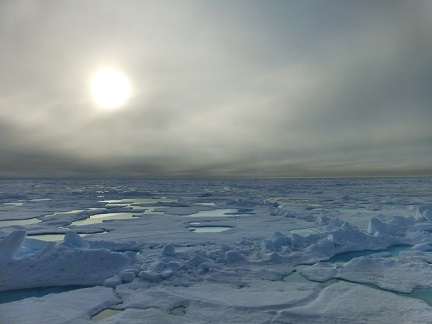
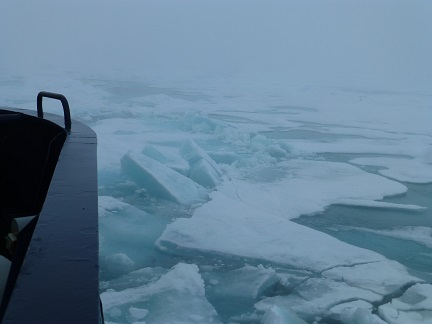
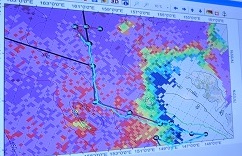 Taking a station in the ice is also an additional challenge: First, we have to find a good stop for the ship, with as much as possible of open water. Usually we go back and forth a bit, to clear away as much ice as possible to make sure to have enough space both in the front and the aft of the ship for getting things into the water. This way we avoid damaging the equipment or the winch wire with the floating ice Taking a station in the ice is also an additional challenge: First, we have to find a good stop for the ship, with as much as possible of open water. Usually we go back and forth a bit, to clear away as much ice as possible to make sure to have enough space both in the front and the aft of the ship for getting things into the water. This way we avoid damaging the equipment or the winch wire with the floating ice
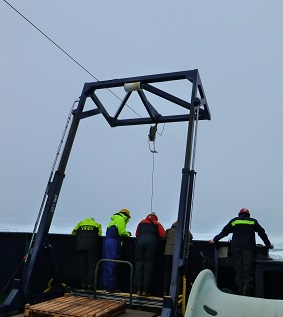 For last night’s station it took us 1.5h of navigating around to get a more or less an ice-free spot to get the CTD in, and even then the operators had to keep pushing drifting ice chunks away with the water hose. While the CTD team is doing their best to get started, I help Emma to deploy her submersible pump from the side of the ship. Compared to the CTD rosette or even our GoFlo, the pump is really small, so it is not a big problem to find some space for it in between the ice sheets. After getting it up again after the (finally successful) CTD, we try to deploy the GoFlo. But first, it needs a bit more space than the pump, and second, three larger ice chunks have been drifting really towards our deployment spot. We try pushing them away using the boat hook and the hose, but no success … so in the end, we decide to give up and only sample from the sweater intake . As the ice conditions are still the same now, we have decided now to take the GoFlo samples from the aft deck: it is much easier to remove the ice from there, the ship just has to go backwards..and ice-free conditions are needed there anyway for all the sediment activities. For last night’s station it took us 1.5h of navigating around to get a more or less an ice-free spot to get the CTD in, and even then the operators had to keep pushing drifting ice chunks away with the water hose. While the CTD team is doing their best to get started, I help Emma to deploy her submersible pump from the side of the ship. Compared to the CTD rosette or even our GoFlo, the pump is really small, so it is not a big problem to find some space for it in between the ice sheets. After getting it up again after the (finally successful) CTD, we try to deploy the GoFlo. But first, it needs a bit more space than the pump, and second, three larger ice chunks have been drifting really towards our deployment spot. We try pushing them away using the boat hook and the hose, but no success … so in the end, we decide to give up and only sample from the sweater intake . As the ice conditions are still the same now, we have decided now to take the GoFlo samples from the aft deck: it is much easier to remove the ice from there, the ship just has to go backwards..and ice-free conditions are needed there anyway for all the sediment activities.
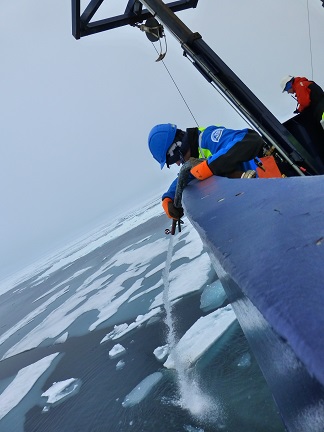 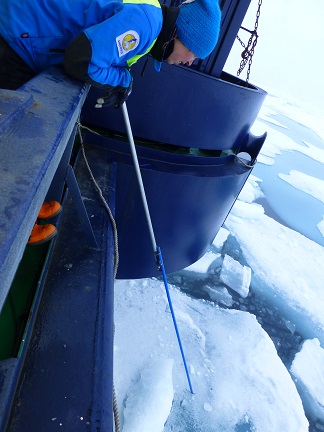
|





 Taking a station in the ice is also an additional challenge: First, we have to find a good stop for the ship, with as much as possible of open water. Usually we go back and forth a bit, to clear away as much ice as possible to make sure to have enough space both in the front and the aft of the ship for getting things into the water. This way we avoid damaging the equipment or the winch wire with the floating ice
Taking a station in the ice is also an additional challenge: First, we have to find a good stop for the ship, with as much as possible of open water. Usually we go back and forth a bit, to clear away as much ice as possible to make sure to have enough space both in the front and the aft of the ship for getting things into the water. This way we avoid damaging the equipment or the winch wire with the floating ice For last night’s station it took us 1.5h of navigating around to get a more or less an ice-free spot to get the CTD in, and even then the operators had to keep pushing drifting ice chunks away with the water hose. While the CTD team is doing their best to get started, I help Emma to deploy her submersible pump from the side of the ship. Compared to the CTD rosette or even our GoFlo, the pump is really small, so it is not a big problem to find some space for it in between the ice sheets. After getting it up again after the (finally successful) CTD, we try to deploy the GoFlo. But first, it needs a bit more space than the pump, and second, three larger ice chunks have been drifting really towards our deployment spot. We try pushing them away using the boat hook and the hose, but no success … so in the end, we decide to give up and only sample from the sweater intake . As the ice conditions are still the same now, we have decided now to take the GoFlo samples from the aft deck: it is much easier to remove the ice from there, the ship just has to go backwards..and ice-free conditions are needed there anyway for all the sediment activities.
For last night’s station it took us 1.5h of navigating around to get a more or less an ice-free spot to get the CTD in, and even then the operators had to keep pushing drifting ice chunks away with the water hose. While the CTD team is doing their best to get started, I help Emma to deploy her submersible pump from the side of the ship. Compared to the CTD rosette or even our GoFlo, the pump is really small, so it is not a big problem to find some space for it in between the ice sheets. After getting it up again after the (finally successful) CTD, we try to deploy the GoFlo. But first, it needs a bit more space than the pump, and second, three larger ice chunks have been drifting really towards our deployment spot. We try pushing them away using the boat hook and the hose, but no success … so in the end, we decide to give up and only sample from the sweater intake . As the ice conditions are still the same now, we have decided now to take the GoFlo samples from the aft deck: it is much easier to remove the ice from there, the ship just has to go backwards..and ice-free conditions are needed there anyway for all the sediment activities.












